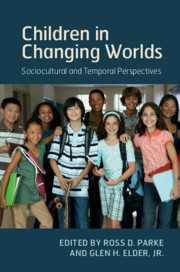Book contents
- Children in Changing Worlds
- Children in Changing Worlds
- Copyright page
- Contents
- List of Figures
- Contributor Biographies
- Preface
- Part I Theoretical and Methodological Approaches: A Cross-Disciplinary Challenge
- Part II Historical and Life Course Transitions: Economic and Demographic Change
- Part III Social, Legal, and Technological Change: Impact on Children
- 7 The Urban World of Minority and Majority Children
- 8 Changing Family Forms: The Implications for Children’s Development
- 9 Communication Technologies and Social Transformation: Their Impact on Human Development
- Part IV Views of the Interdisciplinary Dialogue: From Developmental Science and Sociology
- Author Index
- Subject Index
- References
9 - Communication Technologies and Social Transformation: Their Impact on Human Development
from Part III - Social, Legal, and Technological Change: Impact on Children
Published online by Cambridge University Press: 18 July 2019
- Children in Changing Worlds
- Children in Changing Worlds
- Copyright page
- Contents
- List of Figures
- Contributor Biographies
- Preface
- Part I Theoretical and Methodological Approaches: A Cross-Disciplinary Challenge
- Part II Historical and Life Course Transitions: Economic and Demographic Change
- Part III Social, Legal, and Technological Change: Impact on Children
- 7 The Urban World of Minority and Majority Children
- 8 Changing Family Forms: The Implications for Children’s Development
- 9 Communication Technologies and Social Transformation: Their Impact on Human Development
- Part IV Views of the Interdisciplinary Dialogue: From Developmental Science and Sociology
- Author Index
- Subject Index
- References
Summary
The focus is on developmental effects of communication technologies from print literacy to Internet and smart phones. Longitudinal and cross-sectional comparison sheds light on historical shifts and cross-cultural data. Because there is no evidence that basic media effects are country or ethnicity specific, evidence from multiple countries shows how the historical march of media have affected values, learning environments, and individual development. Cross-cultural evidence suggests that this is indeed a portrait of globalized social change and its implications for human development around the world. Nonetheless, I provide an example of how the global culture engendered by new communications technologies is expressed. Using a theory of social change and human development as a framework I explore developmental implications - social, cognitive, and neural - of the march of media through historical time and across geographical space. Eschewing methodocentrism, I draw on studies employing a variety of methods: content analysis, focus group, survey, field experiment, lab experiment, and fMRI experiment. While before-after comparisons are precious but rare, there are many other research designs that allow us to infer effects of the historical introduction and expansion of a particular communication technology.
- Type
- Chapter
- Information
- Children in Changing WorldsSociocultural and Temporal Perspectives, pp. 235 - 274Publisher: Cambridge University PressPrint publication year: 2019
References
- 6
- Cited by

